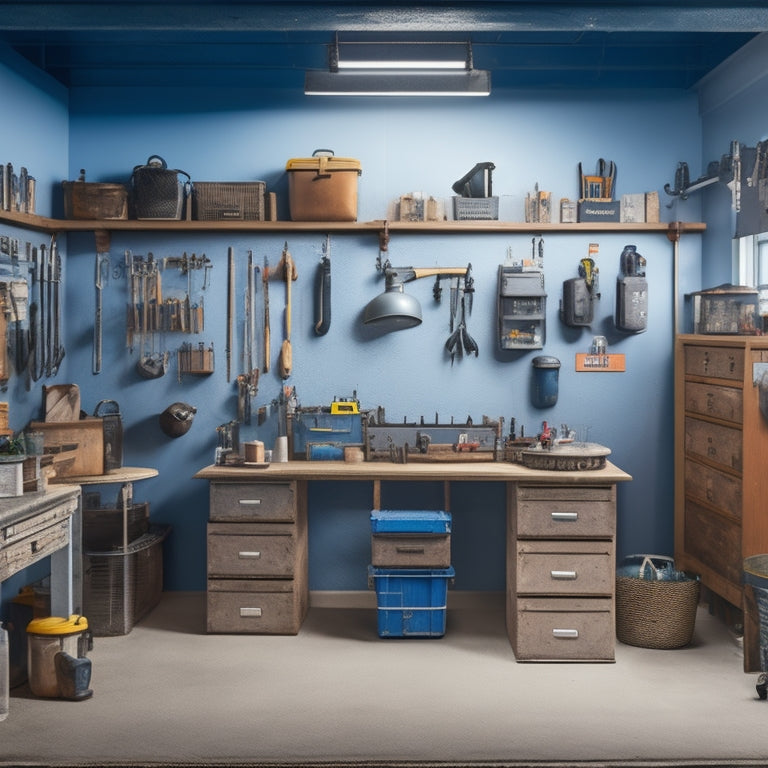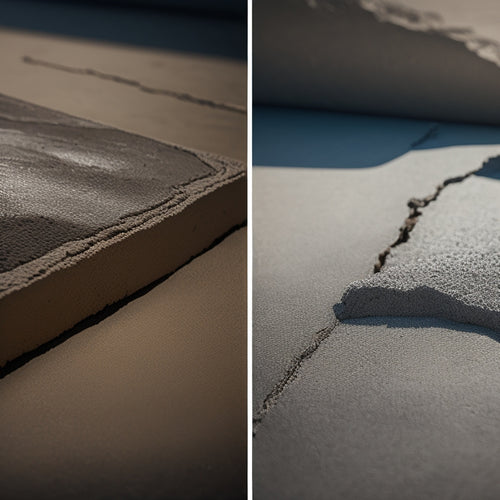
Organize Your Tools for Efficient Concrete Project Management
Share
When organizing your tools for efficient concrete project management, start by evaluating your tool needs based on the specific project requirements, including block type, quantity, and surface preparation needs. Design a tool storage system that prioritizes frequently used tools, allocates prime storage space, and utilizes bins, hooks, cabinets, and pegboards for efficient storage. Then, focus on maximizing storage space efficiency by categorizing tools into functional groups, optimizing layout, and investing in vertical storage solutions. By implementing these strategies, you'll be well on your way to streamlining your workflow and improving productivity - and that's just the beginning.
Key Takeaways
• Determine tool needs based on block type, quantity, and project scope to ensure the right tools are available.
• Design a tool storage system that prioritizes frequently used tools and considers workflow and ergonomic accessibility.
• Categorize tools into functional groups and utilize vertical storage solutions to maximize storage space efficiency.
• Assign team member responsibility for maintaining tool organization and implement a check-in and check-out system to track tool usage.
• Regularly assess and adjust on-site tool storage and organization based on frequently used tools and project requirements.
Assessing Tool Needs for Cinder Block
When building with cinder blocks, you'll need to determine the specific tools required for your project, considering the type and quantity of blocks, the surface preparation needed, and the desired finish. This assessment is essential in guaranteeing you have the right tools for the job, reducing delays, and increasing efficiency.
Effective tool selection strategies involve evaluating the project's scope, identifying the tasks involved, and selecting project-specific tools that cater to those tasks.
For instance, if you're building a retaining wall, you'll need a level, trowel, and jointer to guarantee the blocks are properly aligned and filled. On the other hand, if you're constructing a foundation, you may require a mix of power tools, such as a drill and impact wrench, and manual tools, like a shovel and wheelbarrow.
Designing a Tool Storage System
To maximize your tool storage system's efficiency, design it around your workflow, considering the frequency of tool use, the space available, and the ergonomics of your workspace. This means identifying the most frequently used tool types and allocating prime storage space for them. Less frequently used tools can be stored in less accessible areas or on higher shelves.
When designing your storage system, think about the different tool types you have, such as power tools, hand tools, and accessories. Assign a specific storage solution for each type, like bins for small parts, hooks for hanging tools, and cabinets for larger equipment. Consider using a pegboard for frequently used tools, allowing you to quickly access them when needed.
Remember to also consider the ergonomics of your workspace. Store tools at a comfortable height and distance to reduce strain and fatigue. A well-designed tool storage system won't only save you time but also reduce the risk of injury and improve your overall productivity.
Essential Tools for Sealing Projects
You'll need a range of essential tools to secure a successful concrete sealing project, including sealant applicators, surface preparation tools, and safety equipment.
Sealant applicators, such as sprayers, rollers, and brushes, are vital for applying the right amount of sealant to the concrete surface. When it comes to surface preparation, tools like scrubbers, sanders, and grinders help guarantee the surface is clean and even, allowing for a strong bond between the sealant and concrete.
Your tool selection will also depend on the specific sealing techniques you're using. For example, if you're using a spray-on sealant, you'll need a sprayer with the right nozzle size and pressure setting. If you're applying a sealant by hand, you'll need brushes or rollers with the right nap length and material.
Don't forget to include safety equipment like gloves, safety glasses, and respirators in your toolkit to protect yourself from chemical exposure and other hazards.
Maximizing Storage Space Efficiency
Optimize your storage space by categorizing tools into functional groups, such as sealant applicators, surface preparation tools, and safety equipment, to facilitate quick access and minimize clutter. This approach enables you to identify what you have, where it's stored, and what's missing.
Next, assess your storage area's dimensions and layout to determine the most efficient use of space. Consider investing in vertical storage solutions, such as wall-mounted racks or shelves, to maximize your facility's vertical space. Modular shelving units can also be customized to fit your specific needs, providing a flexible and adaptable storage system.
By implementing these strategies, you'll be able to store more tools in a smaller area, reducing congestion and making it easier to find what you need when you need it. Additionally, labeling each storage unit or shelf can help you quickly locate specific tools, saving you time and increasing productivity.
Maintaining Tool Accessibility On-Site
Now that your tools are organized and stored efficiently in your facility, it's equally important to verify they're accessible on-site, where they're needed most. As you begin a new project, it's essential to make certain your tools are readily available to your team. This means implementing an on-site organization system that allows for easy access to your tool inventory.
Start by designating a specific area for tool storage on-site. This could be a trailer, container, or even a designated zone on the job site. Assign a team member to be responsible for maintaining this area, verifying that tools are returned after use and stored in their designated place.
Implement a check-in and check-out system to track tool usage and prevent loss or misplacement. This will also help you identify which tools are being used most frequently, allowing you to adjust your on-site organization accordingly.
Frequently Asked Questions
Can I Use the Same Tools for Concrete and Masonry Projects?
You're wondering if you can use the same tools for concrete and masonry projects. The answer is, it depends.
While some tools like trowels and mixers can be used for both, others like finishing tools and specialized equipment mightn't be compatible.
Consider the project's requirements and the tool's design before making a decision.
You'll want to guarantee you're using the right tool for the job to maintain project versatility and avoid costly mistakes.
How Do I Prevent Tool Theft on a Construction Site?
You're wise to worry about those 'misplaced' tools on your construction site. Let's face it, theft is a harsh reality.
To safeguard your equipment, implement robust tool security measures, such as labeling and tracking devices.
Consider site surveillance options like cameras and access controls to deter would-be thieves.
Are There Any OSHA Regulations for Tool Storage and Maintenance?
You're on top of tool security, now guarantee you're OSHA-compliant with tool storage and maintenance.
Familiarize yourself with OSHA's tool safety guidelines, which emphasize proper storage to prevent accidents and injuries.
Follow storage guidelines, such as keeping tools in designated areas, using toolboxes with secure lids, and maintaining a clean and organized workspace.
Can I Customize My Tool Storage System for Specific Projects?
You can definitely customize your tool storage system to fit specific project needs.
By creating a custom tool storage setup, you'll boost efficiency and productivity on the job site.
Consider categorizing tools by project phase or task, and label each storage unit accordingly.
This project-specific organization will help you quickly locate the right tools, saving time and reducing frustration.
How Often Should I Inspect and Maintain My Tools?
As you're about to start a new project, it's coincidental that you're thinking about tool maintenance - it's a vital step in prolonging your tool lifespan.
You should inspect and maintain your tools regularly, ideally on a pre-determined maintenance schedule. Set reminders to check for wear and tear, clean and lubricate moving parts, and replace worn-out components.
By doing so, you'll guarantee your tools remain in top condition, reducing downtime and increasing productivity.
Develop a routine that works for you and stick to it.
Conclusion
You've finally got your tool storage system in place, and it's a game-changer!
With a well-organized arsenal of essentials, you'll be tackling concrete projects like a pro in no time.
Your efficiency will be off the charts, and you'll be amazed at how much more you can accomplish in a day.
In fact, you'll be working so fast, you'll think you've cloned yourself a thousand times over!
Related Posts
-

What Tools Do I Need for Concrete Wall Repair
As you prepare for a concrete wall repair job, you'll need a variety of tools to guarantee a successful outcome. Star...
-

Essential Tools for Concrete Wall Covering Projects
When tackling a concrete wall covering project, you'll need a range of essential tools and equipment. For cleaning an...
-

What Tools Ensure Strong Concrete Adhesion at Home
You'll need the right tools to guarantee strong concrete adhesion at home. For surface preparation, use concrete surf...


